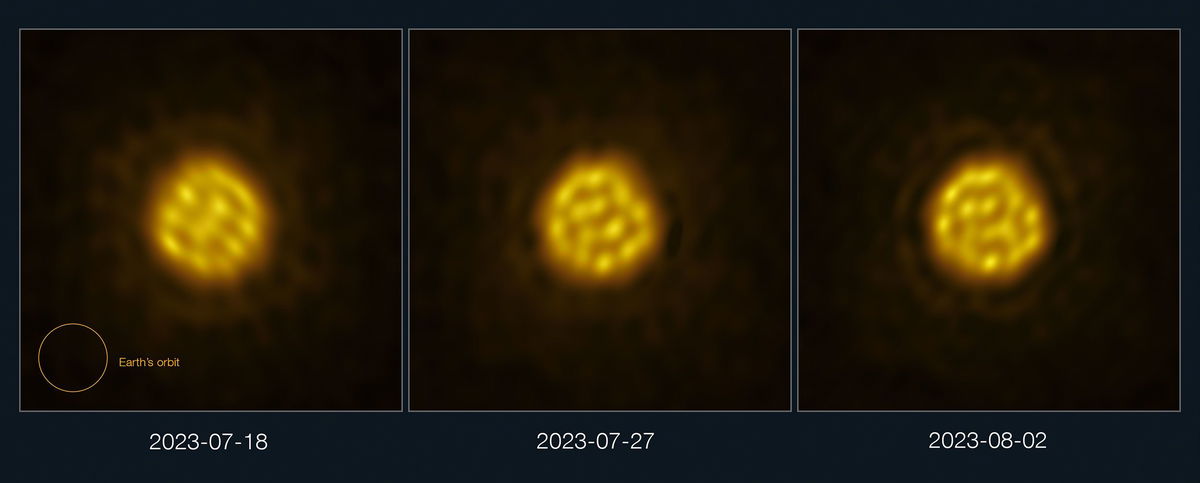Giant bubbles on the surface of a nearby star preview the fate of our sun

Astronomers have captured a sequence of images of a nearby star that track the motion of bubbling gas on its surface.
By Ashley Strickland, CNN
(CNN) — Astronomers have observed the detailed motions of giant gas bubbles on the surface of a nearby star for the first time, which rise and fall like the inside of a lava lamp.
The massive hot gas bubbles are 75 times the size of the sun, and they appear to be sinking down into the star’s interior more rapidly than expected, according to a team of astronomers at Chalmers University of Technology in Sweden.
The images show the surface of the star R. Doradus, a red giant star 180 light-years away in the Dorado constellation. The star has a diameter about 350 times that of the sun, and it serves as a preview for our sun’s future.
In about 5 billion years, our sun will become a red giant, puffing up and expanding as it releases layers of material and likely evaporating the solar system’s inner planets, although Earth’s fate remains unclear, according to NASA.
The observations, made using the Atacama Large Millimeter/submillimeter Array, or ALMA, of telescopes in Chile, mark the first time researchers have tracked such detailed movements on the surface of a star other than the sun.
They published their findings Wednesday in the journal Nature.
“We aimed to observe the gas in the atmosphere around the star and hoped to find signs of the ‘convection’ bubbles that were expected to exist,” said lead study author Wouter Vlemmings, a professor of astronomy and plasma physics at Chalmers, in an email. “However, we did not expect to see them in such detail and to actually be able to see their movement.”
When stars age
Vlemmings and his colleagues study what occurs as stars near the end of their lifetimes.
Stars produce energy within their cores through nuclear fusion by squeezing hydrogen atoms to form helium. This process heats the star and fuels it for billions of years.
Energy produced in the core can be delivered to the star’s surface through huge, hot bubbles of gas, which then sink as they cool down, similar to what happens in a lava lamp.
This process, known as convection, mixes elements created in the core such as carbon and nitrogen throughout the star, according to the study authors. Convection is also the likely instigator of stellar winds, or rapid winds that can whisk elements made by the star into space to help create new stars and planets.
When a star’s life ends, it runs out of hydrogen to convert into helium, causing the star’s core to collapse. This pressure on the core also increases the star’s temperature, which causes it to puff up and swell into a red giant, according to NASA.
As they near the end of their lives, the topmost layers of the stars blow off, and eventually the stars collapse or explode, releasing the elements created inside them into space.
“We are all made of ‘stardust,’ and much of the material around us is made in stars,” Vlemmings said. “How this material is ejected from old stars to be incorporated in new stars and planets is still not completely clear.”
Gazing at old stars
The team decided to observe R. Doradus because it’s one of the nearest and largest red giant stars, making it easier to watch. The telescope enabled them to collect high-resolution images of the star’s surface over the course of a month.
“Convection creates the beautiful granular structure seen on the surface of our Sun, but it is hard to see on other stars,” said study coauthor Theo Khouri, a researcher at Chalmers, in a statement. “With ALMA, we have now been able to not only directly see convective granules — with a size 75 times the size of our Sun! — but also measure how fast they move for the first time.”
The sun’s outermost layer, called the photosphere, is made of gas so hot that it bubbles. The sun’s photosphere is full of millions of bubbles formed through convection. The gas bubbles, also known as convective granules, are about 621 miles (1,000 kilometers) across and move at speeds of a few kilometers per second, so they only survive for about 10 minutes.
But the convective cells on R. Doradus’ surface are more than 100 million kilometers (about 62 million miles) in size, with velocities of a few tens of kilometers per second, and persist for about a month.
“We don’t yet know what is the reason for the difference. It seems that convection changes as a star gets older in ways that we don’t yet understand,” Vlemmings said.
While convection bubbles have been spotted before on the surface of stars, the new observations tracked the motion of bubbles in a way that wasn’t possible earlier.
“It is spectacular that we can now directly image the details on the surface of stars so far away, and observe physics that until now was mostly only observable in our Sun,” said study coauthor Behzad Bojnordi Arbab, a doctoral student at Chalmers, in a statement.
The new study includes longer observations than previous ones, which captured the evolution of the bubbles, said Dr. Claudia Paladini, associate astronomer at the European Southern Observatory in Chile. Paladini authored a study on the observation of bubbles on the surface of the star pi1 Gruis. While she was not involved in the new research, she authored an article that accompanies the study in Nature.
“One can see the bubbles coming up, expanding, and vanishing like it’s seen in the Sun. It’s remarkable considering the distance we are talking about,” Paladini said. “Now we just need to observe many more of these stars!”
The-CNN-Wire
™ & © 2024 Cable News Network, Inc., a Warner Bros. Discovery Company. All rights reserved.
